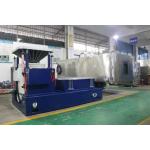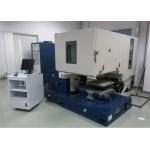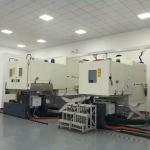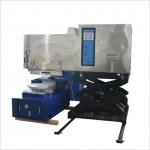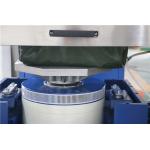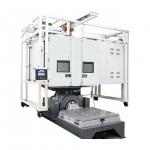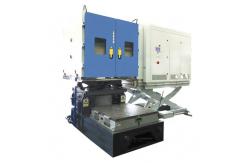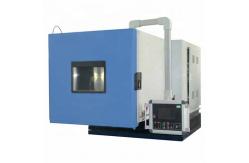In the highly competitive automotive industry, ensuring the
reliability and durability of components is not just a goal but an
absolute necessity. The HALT HASS & AGREE Vibration Test
Chambers, specifically designed to perform the GMW14785 pressure
vibration test and meet the GMW14785 PVT Cycle Test, emerge as a
crucial asset in the pursuit of automotive excellence. This advanced vibration test chamber is dedicated to subjecting
automotive components to the rigorous GMW14785 pressure vibration
test and fulfilling the requirements of the GMW14785 PVT Cycle
Test. It caters to automotive manufacturers, Tier 1 suppliers, and
research institutions. The primary objective is to evaluate the
performance and integrity of components under the combined stress
of pressure and vibration, replicating the real-world and extreme
conditions that these parts may encounter during a vehicle's
operation. By precisely simulating these complex scenarios,
manufacturers can identify design flaws, optimize component
designs, and enhance the overall quality and safety of automotive
products. - Robust and Customizable Chamber Construction
- The chamber is built with heavy-duty materials to withstand the
intense forces generated during pressure vibration testing. The
walls are made of high-strength steel with excellent sealing
properties to maintain the required pressure levels. The interior
is designed to accommodate a wide variety of automotive components,
from small electronic modules to larger mechanical assemblies. The
door is equipped with a reliable sealing mechanism and a viewing
window, allowing operators to closely monitor the testing process.
The chamber can be customized in terms of size and internal layout
to meet specific testing needs.
- Precision Pressure and Vibration Control Systems
- Pressure Control: Capable of achieving a wide range of pressures,
typically from vacuum levels up to several atmospheres, with an
accuracy of ±0.1% of the set value. The system utilizes advanced
pressure pumps, valves, and sensors to ensure accurate and stable
pressure regulation. This allows for the simulation of different
pressure environments that automotive components may experience,
such as those in fuel systems, hydraulic circuits, or in
high-altitude or deep-sea driving conditions.
- Vibration System: The chamber is equipped with a high-performance
vibration platform that can generate a broad spectrum of vibration
frequencies and amplitudes. It can produce vibrations from 5 Hz to
2000 Hz with amplitudes up to 50 mm. The vibration system is
designed to replicate various real-world vibration sources,
including engine vibrations, road surface irregularities, and the
dynamic forces associated with vehicle maneuvers. The vibration
control system is highly precise, enabling the programming of
complex vibration profiles and real-time adjustments.
- Intuitive Control Panel and Data Acquisition Interface
- The control panel is user-friendly and provides easy access to all
test parameters. Operators can set and adjust pressure levels,
vibration frequencies, amplitudes, and test durations with minimal
effort. The panel also displays real-time information about the
current pressure, vibration status, and any alarms or warnings. The
chamber is integrated with a comprehensive data acquisition system
that records all relevant test data. This includes pressure
histories, vibration waveforms, and any observable changes in the
component's performance or integrity. The data can be stored in a
built-in memory or exported to external storage devices for further
analysis. The system can also generate detailed test reports in
various formats.
- Safety Features and Alarms
- To ensure the safety of operators and the protection of the test
specimens and the chamber itself, a range of safety features is
incorporated. These include over-pressure and over-vibration
protection systems, emergency stop buttons, and alarms for abnormal
pressure fluctuations, vibration malfunctions, or any other
equipment failures. The chamber is also equipped with proper
ventilation and exhaust systems to handle any potentially harmful
gases or vapors that may be generated during the testing process.
- Pressure Range and Accuracy
- The wide pressure range from vacuum to several atmospheres with
±0.1% accuracy enables a comprehensive evaluation of automotive
components. For example, fuel injectors need to function properly
under different fuel pressure conditions, and seals must hold up
against varying pressure differentials. The accurate pressure
control ensures that the test conditions are precisely maintained,
providing reliable and repeatable results.
- Vibration Parameters
- The vibration system's ability to produce frequencies from 5 Hz to
2000 Hz and amplitudes up to 50 mm allows for the replication of
diverse driving conditions. Low-frequency vibrations can mimic the
rumble of a rough road, while high-frequency vibrations can
simulate the rapid oscillations of an engine or a high-speed
rotating component. The precise control of vibration frequency and
amplitude is essential for a thorough assessment of the component's
resistance to vibration-induced failures.
- PVT Cycle Parameters
- The GMW14785 PVT Cycle Test involves specific combinations of
pressure and vibration profiles. The chamber can be programmed to
execute these cycles accurately, including the sequence and
duration of pressure changes and vibration applications. For
instance, a component may be subjected to a series of pressure
pulses while simultaneously experiencing a particular vibration
frequency and amplitude, and the chamber can precisely replicate
such complex scenarios.
- Testing Volume and Payload Capacity
|
